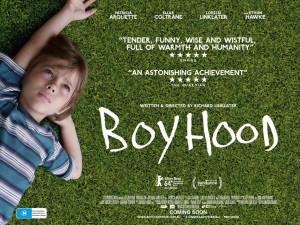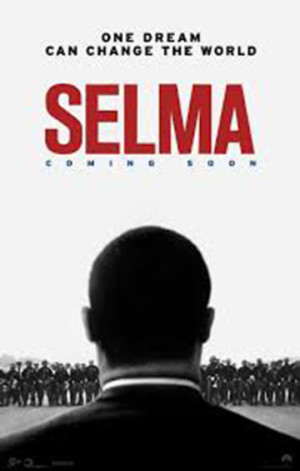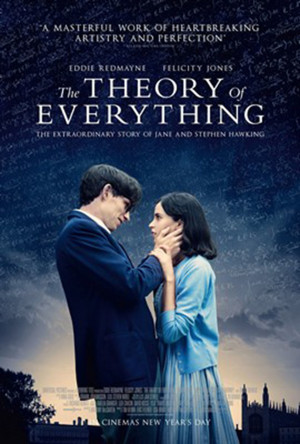Your donation will support the student journalists of Hagerty High School. We are an ad-free publication, and your contribution helps us publish six issues of the BluePrint and cover our annual website hosting costs. Thank you so much!
The Oscars: Hagerty Edition
When it comes to the Academy Awards, everyone has their favorites. We chose who we think will win Picture of the Year at the Oscars on Sunday, Feb. 22, and who we wish would win.
Our Predicted Winner: Boyhood
The usual time it takes to film a movie is six to eight months, but director Richard Linklater took 12 years to film Boyhood, the story of the not-so-average boy going through puberty and growing up with a single mother, slowly emo-growing sister, estranged father and series of alcoholic step-fathers.
Once a year, the cast of Boyhood, headed by lead actor Eller Coltrain, taped for one to three months from the time Coltrain was eight until he was 20. The story of the movie is split up into 12 time frames, each seen through changes in the cast’s age, or Coltrain’s character’s hair become longer and slightly greasier. The movie was filmed on location in Texas, the setting of the movie.
Despite a bland storyline, the acting quality of the movie made up for it ten-fold. Patricia Arquette and Ethan Hawke, Coltrain’s on-screen biological parents, carried the movie. Hawke’s portrayal of the around-half-of-the-time father was perfect, complete with cursing in front of small children and awkward dad jokes. Though her character may have been infuriating, Arquette expertly displayed the effects of violent marriages, struggles in gaining a college degree with children, and the woes of an empty nest, despite her terrible bowl cuts and bobs.
Though it may not have been the most heart-wrenching, fast-paced or tear-inducing film, the unique way in which Boyhood was filmed makes it a winner. By pioneering its way into new frontiers of movie-making, the Academy will choose Boyhood to take home the award for Best Picture of the year.
What we want to win: Selma
Since its release on Jan. 9, not a single person watching Selma has had a dry eye. Selma’s dramatic interpretation of the march from Selma, Ala. to Birmingham in 1964 brought the full impact of the events to life in a captivating and inspiring manner.
While the movie did not show every iconic moment of the Civil Rights Movement, this made the story of Selma even more powerful. With all the focus on this single event, this movie feels months long even though it only spans a few weeks of King’s life. This focus on a single event allowed the audience to realize how much planning was put into the march and how much it impacted King’s homelife, such as the effect the movement had on his wife and his marriage. While the film has come under fire from critics who claim King’s and LBJ’s relationship was “mischaracterized,” the film only slightly altered their friendship to add to the drama of the movie. Selma is certainly not the first historical film to do so.
The release of the movie is one more aspect that made Selma great. While of course the film did not plan for this, the film could not have been released at a better date. With the recent deaths of Michael Brown in Ferguson and Eric Gardner in Staten Island, emotion ran high throughout. Rapper Common, who appeared in the movie, even mentioned Ferguson in the song he made for the closing credits. The film also inspired people in New York, Philadelphia and other major cities to march on Martin Luther King, Jr. Day.
Selma did especially well in portraying the mostly undisclosed, personal life of King. His family was an evident factor in his motivation. The private connection that viewers develop during the movie makes it much more of a reality. There are personable, domestic scenes for most people to identify with, as well as scenes of a casual meeting or a friendly lunch. This brings much more value to their cause, seeing the leaders of the movement as people instead of legends.
With a brilliant cast, it uses evident that the roles chose the actors, instead of the actors choosing the roles. There were little to no long-standing, well-known actors used in this film. The cast was assigned based on the actors’ ability to embrace the part assigned, not on their ability to increase ticket sales through their infinite fan base.
David Oyelowo played a phenomenal Martin Luther King, Jr. Although a relative unknown, he gave off an aura of familiarity through his poignantly Southern manner of speaking and ability to capture the emotions that sprung from the storyline. Everything about him screamed Martin Luther King. When his character hurt, the audience felt his pain. When he was triumphant, his observers couldn’t help but smile. His performance alone gave credibility to the film by appearing exactly how everyone pictures King.
The role of King’s wife Coretta went to Carmen Ejogo who used her vibrant emotions to portray the struggle of balancing her family and a larger cause. The way her character was written into the film, the way she carried out the role, and the interactions between her and Oyelowo showed the strength and sacrifice it took in the fight for equality.
The reality this movie depicts sheds light on the subject of the Civil Rights movement even though it was reality most would rather forget. One of the most chilling scenes is the standoff at the bridge white supremacists and an accompanying police force are brandishing their makeshift weapons. Barbed wire is being wrapped around a baseball bat, and that is the powerful moment that makes you realize what horrors the protestors actually faced.
While moments in Selma can be unsettling and alarming, this is exactly the kind of movie needed to remind the nation of its past. Selma should win best picture for spreading the message of equality that this country stands for.
Our Runner Up: The Theory of Everything
When you see hot, fresh British actor Eddie Redmayne, you think abs, not deformity due to Amyotrophic Lateral Sclerosis or ALS. However, Redmayne, alongside British actress Felicity Jones, played Stephen and Jane Hawking from their time in college in the 60s, to their divorce in 1995, portraying the two perfectly in a heart-warming story of not only love, but friendship and surviving through hardship.
The Theory of Everything is first and foremost a love story. The movie begins with the Hawkings’ first meeting, and progresses through their marriage, and the slow deterioration of Stephen’s body. One reason this movie was so impactful was because of Jane’s strong, gritty character. She refused to leave Hawking, and even married him, knowing it was predicted that he would die in two years.
However, Hawking’s the revolutionary scientific ideas about the universe and time were equally portrayed throughout the film in a unique way. When Hawking came to each of his conclusions, he was looking at an everyday object – a cup of coffee, for instance – when genius struck him. Though most of us probably still do not understand universal theory even after the movie, the ideas were made easier to understand, which simultaneously added to the overall effect of the movie.
Perhaps it was his brilliance, or perhaps it was their strong-willed work to stay together, but Stephen and Jane Hawking’s story left an impactful yet fuzzy feeling with its wide ranged audiences.




